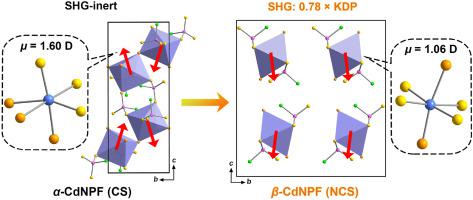当前位置:
X-MOL 学术
›
Mater. Today Phys.
›
论文详情
Our official English website, www.x-mol.net, welcomes your
feedback! (Note: you will need to create a separate account there.)
Isomeric Cd(NH4)2(PO3F)2·2H2O: Solution concentration-driven elimination of antiparallel dipole-dipole interaction generating an SHG β phase
Materials Today Physics ( IF 10.0 ) Pub Date : 2023-01-31 , DOI: 10.1016/j.mtphys.2023.100999
Xin-Rui Yang , Xin Liu , Xue-Bin Deng , Ling Chen , Li-Ming Wu
Materials Today Physics ( IF 10.0 ) Pub Date : 2023-01-31 , DOI: 10.1016/j.mtphys.2023.100999
Xin-Rui Yang , Xin Liu , Xue-Bin Deng , Ling Chen , Li-Ming Wu

|
As the core of all-solid-state lasers, the second harmonic generation (SHG) inorganic crystals exclusively require a noncentrosymmetric (NCS) structure. However, the vast majority of the known inorganic compounds, approximately 79%, are centrosymmetric (CS). Herein, we report a unique concentration-driven isomerization of the and phases of Cd(NH)(POF)·2HO, -CdNPF (2, NCS) and -CdNPF (2/, CS). The NCS -CdNPF is generated at a higher mother solution concentration ( vs. phase: 0.20 vs. 0.15 M), which allows the [CdO] octahedron accommodate higher number of the [POF] ligand with a weak crystal field (CN = 4 vs. 3), leading to a dipole moment reduction (1.06 D vs. 1.60 D) that eventually eliminates the unwanted symmetric center trap induced by the antiparallel dipole-dipole interactions between the [CdO] octahedra in the CS -CdNPF. Interestingly, such a slight - vs. -[CdO] geometry difference in the and phases, also makes the Cd-fluorescence red-shift slightly (437 vs. 431 nm) and narrows slimly (cal.: 4.01 vs. 4.05 eV). More interestingly, -CdNPF exhibits excellent NLO properties (relatively strong phase matching SHG: 0.78 × KDP at 1064 nm; deep ultraviolet (DUV) transparent ( < 200 nm); high laser induced damage threshold: 1.48 × KDP), indicating a promising DUV NLO application potential.
中文翻译:

异构Cd(NH4)2(PO3F)2·2H2O:溶液浓度驱动消除反平行偶极子-偶极子相互作用,产生SHG β相
作为全固态激光器的核心,二次谐波产生(SHG)无机晶体只需要非中心对称(NCS)结构。然而,绝大多数已知的无机化合物(约 79%)是中心对称的 (CS)。在此,我们报道了 Cd(NH)(POF)·2HO、-CdNPF (2, NCS) 和 -CdNPF (2/, CS) 的独特的浓度驱动异构化和相。 NCS -CdNPF 是在较高的母液浓度(相对于相:0.20 vs. 0.15 M)下生成的,这使得 [CdO] 八面体能够容纳更多数量的具有弱晶体场的 [POF] 配体(CN = 4 vs . 3),导致偶极矩减小(1.06 D vs. 1.60 D),最终消除了由 CS -CdNPF 中的 [CdO] 八面体之间的反平行偶极-偶极相互作用引起的不需要的对称中心陷阱。有趣的是,在 和 相中如此轻微的 - 与 -[CdO] 几何形状差异,也使得 Cd 荧光轻微红移(437 与 431 nm)并略微变窄(校准:4.01 与 4.05 eV)。更有趣的是,-CdNPF表现出优异的NLO性能(相对较强的相位匹配SHG:1064 nm处0.78 × KDP;深紫外(DUV)透明(< 200 nm);高激光诱导损伤阈值:1.48 × KDP),表明DUV是一种有前途的材料非线性光学应用潜力。
更新日期:2023-01-31
中文翻译:

异构Cd(NH4)2(PO3F)2·2H2O:溶液浓度驱动消除反平行偶极子-偶极子相互作用,产生SHG β相
作为全固态激光器的核心,二次谐波产生(SHG)无机晶体只需要非中心对称(NCS)结构。然而,绝大多数已知的无机化合物(约 79%)是中心对称的 (CS)。在此,我们报道了 Cd(NH)(POF)·2HO、-CdNPF (2, NCS) 和 -CdNPF (2/, CS) 的独特的浓度驱动异构化和相。 NCS -CdNPF 是在较高的母液浓度(相对于相:0.20 vs. 0.15 M)下生成的,这使得 [CdO] 八面体能够容纳更多数量的具有弱晶体场的 [POF] 配体(CN = 4 vs . 3),导致偶极矩减小(1.06 D vs. 1.60 D),最终消除了由 CS -CdNPF 中的 [CdO] 八面体之间的反平行偶极-偶极相互作用引起的不需要的对称中心陷阱。有趣的是,在 和 相中如此轻微的 - 与 -[CdO] 几何形状差异,也使得 Cd 荧光轻微红移(437 与 431 nm)并略微变窄(校准:4.01 与 4.05 eV)。更有趣的是,-CdNPF表现出优异的NLO性能(相对较强的相位匹配SHG:1064 nm处0.78 × KDP;深紫外(DUV)透明(< 200 nm);高激光诱导损伤阈值:1.48 × KDP),表明DUV是一种有前途的材料非线性光学应用潜力。

































 京公网安备 11010802027423号
京公网安备 11010802027423号